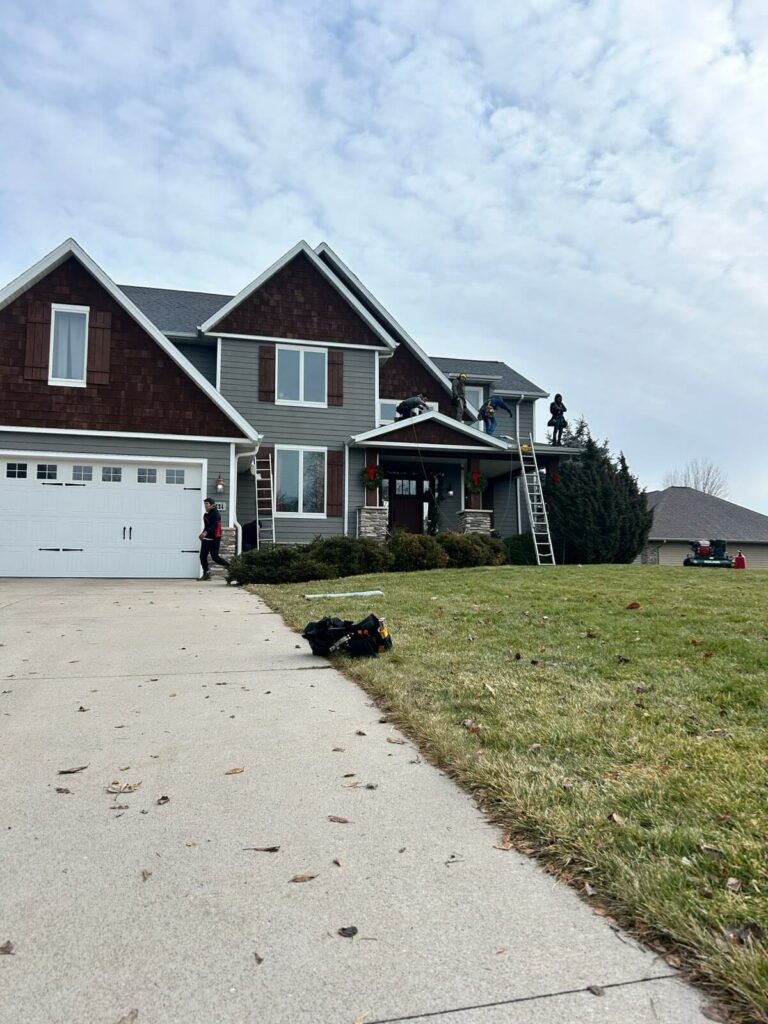In the realm of home maintenance, the significance of proper roof ventilation cannot be overstated. It stands as a critical mechanism for warding off moisture accumulation, moderating attic temperatures, and slashing cooling expenses. The process hinges on a simple yet effective principle: intake vents draw fresh air into the attic, while exhaust vents expel the hot, moist air, fostering a balanced and healthy environment. The repercussions of neglecting this aspect of roof care range from the proliferation of mold and mildew to the premature deterioration of roof materials. This article delves into the intricacies of roof ventilation, elucidating its operation, the telltale signs of ventilation deficiencies, and practical measures to enhance your roof’s breathing capability. Through a comprehensive exploration of different vent types and maintenance tips, you’ll be equipped with the knowledge to safeguard your home against the pitfalls of poor ventilation. Rosenow Customs, a premier roofing contractor in Northeast Wisconsin, underscores the importance of professional roof ventilation services to maintain your home’s integrity and comfort.
What is proper roof ventilation?
Proper roof ventilation is a system designed to ensure a continuous flow of air through the attic space, balancing the intake of fresh, cool air with the exhaust of hot, moist air. This equilibrium is vital for maintaining a healthy, moisture-free environment in the attic, which in turn, protects the roof structure and materials from damage. The system typically consists of intake vents, located at the lowest point of the roof, usually near the soffits, and exhaust vents, positioned at or near the roof’s peak. This setup leverages natural convection to promote air circulation, effectively regulating the temperature and humidity levels within the attic. Proper ventilation is not just about having vents but ensuring they are adequately sized and correctly distributed to facilitate efficient airflow throughout the attic space.
Why is proper roof ventilation crucial?
Proper roof ventilation is pivotal in preserving the integrity of your home, offering two primary benefits: preventing moisture buildup and regulating attic temperature. Moisture accumulation can lead to the growth of mold and mildew, compromising the air quality inside your home and potentially causing health issues. By ensuring a steady flow of air, proper ventilation mitigates this risk, keeping the attic dry and free from harmful growths. Additionally, a well-ventilated attic contributes to a more comfortable living environment by maintaining cooler attic temperatures during hot weather. This, in turn, reduces the burden on your cooling system, leading to lower energy bills. In essence, proper roof ventilation is crucial for both the structural health of your home and the comfort and safety of its occupants.
Prevents moisture buildup, reducing mold risk
Proper roof ventilation plays a pivotal role in minimizing moisture accumulation within your attic. This is crucial for preventing the growth of mold and mildew, which can compromise both the structural integrity of your home and the health of its residents. By ensuring a steady circulation of air, ventilation systems keep the attic environment dry, effectively creating unfavorable conditions for mold and mildew proliferation.
Regulates attic temperature, lowering cooling costs
Additionally, effective roof ventilation is key to regulating the temperature in your attic during the warmer months. An attic without proper ventilation can experience significantly higher temperatures, forcing your air conditioning system to work harder and increasing your energy expenses. By facilitating the expulsion of hot air, a well-ventilated attic maintains a cooler temperature, leading to reduced cooling costs and extending the lifespan of your cooling system.
How does roof ventilation operate?
Roof ventilation operates on a straightforward principle: it ensures a balanced airflow within the attic by allowing fresh air to enter and hot, moist air to exit. This is achieved through two main components: intake vents and exhaust vents. Intake vents are typically situated at the roof’s lowest points, drawing cool air into the attic. Conversely, exhaust vents are located at or near the peak of the roof, facilitating the escape of warm, humid air. This system of intake and exhaust creates a natural convection flow, effectively regulating the attic’s temperature and humidity levels. By maintaining this continuous air movement, roof ventilation prevents moisture accumulation and overheating, safeguarding the home’s structural integrity and enhancing indoor comfort.
Intake vents allow fresh air in
Intake vents, strategically positioned at the roof’s lower sections near the eaves or soffits, play a crucial role in drawing fresh, cool air into the attic. This influx of cooler air is essential for maintaining an optimal temperature balance within the attic space. By facilitating the entry of fresh air, intake vents are the first step in ensuring effective ventilation, keeping the attic environment dry and well-aerated.
Exhaust vents let hot, moist air out
Conversely, exhaust vents, located at or near the roof’s peak, are tasked with expelling hot, moist air from the attic. This expulsion of warm air is vital in preventing moisture accumulation, which can lead to mold growth and structural damage. Working in concert with intake vents, exhaust vents create a continuous airflow that maintains a healthy attic environment and prevents overheating, safeguarding the home’s structural integrity.
Signs of inadequate roof ventilation
Recognizing the signs of inadequate roof ventilation is key to preventing long-term damage to your home. One of the most visible indicators is the formation of ice dams on the roof’s edge during colder months, caused by uneven roof temperatures. Additionally, a spike in energy bills during summer can signal poor ventilation, as your cooling system works overtime to compensate for the excessive heat buildup in the attic. These signs not only highlight ventilation issues but also underscore the urgency of addressing them to protect your home’s structural integrity and ensure a comfortable living environment.
Ice dams forming on the roof’s edge
Ice dams on the roof’s edge serve as a clear indicator of inadequate ventilation. These formations occur when warmth from an improperly ventilated attic causes snow on the roof to melt. The water then flows to the roof’s edge, refreezes, and forms a dam. This phenomenon not only signals that warm air is not being efficiently expelled from the attic but also poses a significant risk of water damage to both the roof and the home’s interior.
Spike in energy bills during summer
A noticeable increase in energy bills during the summer months can be a telltale sign of poor roof ventilation. Trapped hot air in the attic, due to insufficient ventilation, necessitates your air conditioning system to work overtime to cool down the home, leading to higher energy consumption. Addressing ventilation issues can contribute to stabilizing energy usage and reducing cooling costs.
Types of roof vents explained
The effectiveness of a roof ventilation system is significantly influenced by the types of vents used. Ridge vents, strategically placed along the roof peak, are designed for the optimal exhaust of hot air, leveraging their elevated position. Soffit vents, located under the roof’s overhang, primarily serve as intake vents, drawing cool, fresh air into the attic. Gable vents, situated on the end walls of a house, have the versatility to act as either intake or exhaust vents, depending on the wind direction and other environmental factors. Each type of vent plays a crucial role in creating a balanced ventilation system, ensuring efficient air circulation that protects the home from moisture damage and helps regulate attic temperature. Understanding the specific function and optimal placement of these vents is vital for maintaining a healthy, well-ventilated attic space.
Ridge vents along the roof peak
Ridge vents, strategically installed along the roof’s peak, serve as a critical component of the roof’s exhaust system. Their elevated placement allows for the efficient expulsion of hot, moist air that naturally rises to the attic’s highest point, thus facilitating optimal air circulation. This vent type is key to maintaining a continuous airflow, significantly enhancing the overall ventilation of the attic space.
Soffit vents under the roof’s overhang
Located beneath the roof’s overhang, soffit vents play a vital role as the primary intake vents. They are designed to draw in cool, fresh air into the attic, which is essential for displacing the hot air that accumulates above. Their strategic positioning ensures a smooth and even distribution of incoming air across the attic, crucial for effective temperature and moisture regulation.
Gable vents on the end walls
Gable vents are positioned on the house’s end walls, near the roof’s peak but on vertical surfaces. Capable of functioning as either intake or exhaust vents, their performance is influenced by the wind direction and other environmental factors. Gable vents are particularly effective in homes with gable roofs, promoting cross-ventilation and contributing to a balanced attic ventilation system.
Improving your roof’s ventilation system
Enhancing your roof’s ventilation system is essential for the health and longevity of your home. A key strategy involves installing additional vents to achieve a balanced airflow between intake and exhaust, crucial for effective ventilation. It’s equally important to ensure vents are unblocked; obstructions can significantly hinder airflow, undermining the effectiveness of the system. Regular maintenance and inspections are vital to identify and address such issues, facilitating efficient air circulation throughout the attic. By implementing these measures, homeowners can safeguard their property against moisture-related damage, regulate attic temperatures more effectively, and potentially reduce energy costs.
Installing additional vents for balanced airflow
Achieving a balanced and efficient ventilation system often necessitates installing additional vents. This step ensures an equal distribution of intake and exhaust vents, which is essential for maintaining optimal airflow through the attic. A well-balanced system is key to preventing common ventilation issues such as overheating and moisture buildup, thereby safeguarding the roof structure and the interior spaces from potential damage.
Ensuring vents are unblocked for efficiency
To ensure the ventilation system operates at peak efficiency, it’s crucial that all vents remain unblocked and free of obstructions. Over time, vents can become blocked by debris, nests, or even insulation, significantly impeding airflow. Regular inspections and maintenance are necessary to guarantee that air can circulate freely, optimizing the system’s capability to effectively regulate the attic’s temperature and moisture levels.
Consequences of ignoring ventilation
Ignoring the ventilation needs of your roof can have serious repercussions for your home. Inadequate ventilation leads to moisture accumulation in the attic, fostering an ideal environment for mold and mildew growth. This not only poses significant health risks but can also cause the deterioration of wooden structures and insulation. Moreover, the buildup of heat and humidity can accelerate the premature decay of roof materials, reducing the lifespan of your roof. Additionally, higher attic temperatures may force your cooling system to overwork, resulting in increased energy bills. Promptly addressing ventilation issues is crucial to avoid these costly and damaging consequences.
Mold and mildew in attic spaces
Inadequate ventilation in attic spaces can create a damp environment that is ideal for the growth of mold and mildew. These harmful fungi not only degrade the air quality within your home, posing significant health risks to residents, but also cause damage to building materials. Ensuring proper airflow through effective ventilation is crucial to keeping attic spaces dry and preventing these detrimental issues.
Premature roof structure and material decay
Furthermore, neglecting proper ventilation can lead to the premature decay of both the roof structure and its materials. Moisture and heat trapped within the attic can weaken the roof’s structural integrity and accelerate the wear and tear on roofing materials. This results in the necessity for costly repairs or even complete replacements sooner than expected. Adequate ventilation is essential for preserving the lifespan of your roof and safeguarding the overall health of your home.
Roof ventilation inspection guidelines
To safeguard the longevity and functionality of your roof’s ventilation system, adhering to annual inspection guidelines is crucial. Annual checks by roofing professionals are highly recommended to spot any potential issues early. These inspections are vital for identifying blocked vents, assessing the adequacy of the ventilation design, or spotting damage that could restrict airflow. Early detection through these inspections enables timely corrective measures, averting the negative impacts of inadequate ventilation, such as mold proliferation or structural deterioration. Consulting a professional ensures a comprehensive evaluation, maintaining your ventilation system’s optimal performance throughout the year.
Annual checks by roofing professionals advised
Annual inspections by roofing professionals are strongly recommended to uphold the health and functionality of your roof’s ventilation system. These experts possess the necessary skills to detect issues that might not be apparent to homeowners, including blocked vents, inadequate ventilation design, or early signs of wear and damage that could compromise airflow. Regular professional evaluations are essential for preemptively addressing potential problems, thus preventing the development of issues like mold growth or structural damage. Ensuring your ventilation system is inspected annually by a professional is key to maintaining its optimal performance.







